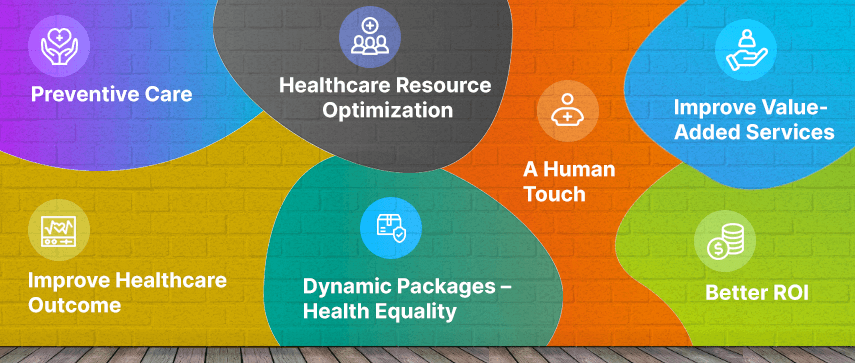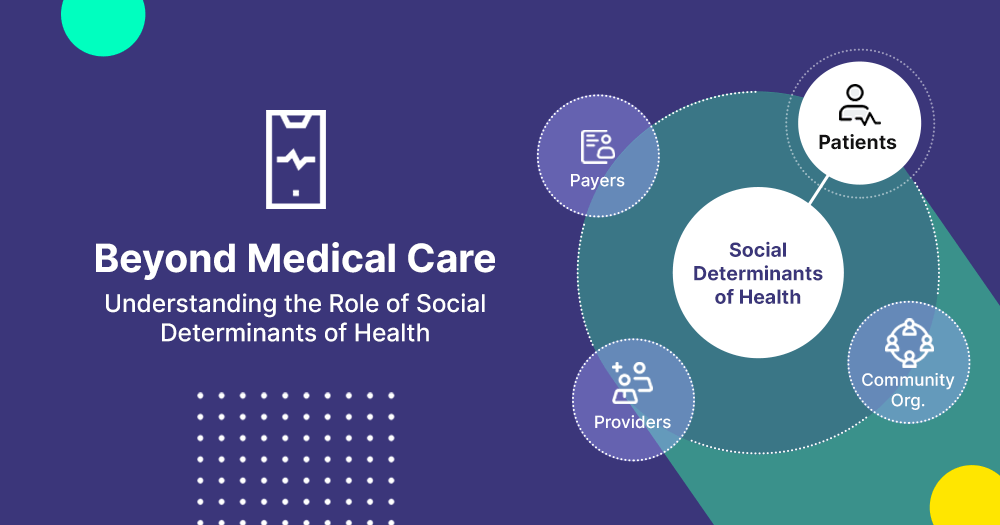The Social Determinants of Health (SDoH) are vital and have a significant impact on healthcare outcomes of the community. The SDoH affects health, living standard, quality of life, the general functioning of human beings, which promotes good health for all. Today, we will discuss the same and explore the concept in detail.
All about the Social Determinants of Health
Health is not about medical care alone. It is a complex and multidimensional factor induced by several non-healthcare factors, societal roles, biological elements, and behavior factors. SDoH is the list of environmental conditions in which people born, live, age, grow, or work, as per WHO. It affects the entire quality of one's life, social engagement, security, influence, access to resources, and more.
However, SDoH is highly influenced by the social needs and social risks of any individual. Food, housing, clothing, transportation, and other non-medical needs are recognized as social needs. And lack of these social needs in one's life adversely affects health outcomes such as food insecurity, education, or unemployment. It may be different depending upon the situation. For instance, a lack of proper education leads to inadequate income, which leads to healthcare inaccessibility and malnutrition. This connection will also affect the next generation growing in the same environment.
Factors of SDoH
Major factors of SDoH as defined by Healthy People are - economic stability, education, health care, neighborhood, and social context. Let us understand it.
Economic Stability
The economic stability of an individual depends on one's employment. Good employment will provide adequate remuneration, which avoids food insecurity, housing instability, or poverty.
Education
Economic stability and education are well-connected. Early childhood development and education are important factors, apart from high school education, higher education, language development, and more.
Community and Social Context
This factor includes elements like social cohesion, discrimination, civic participation, incarceration, and others.
Health Care Access
As mentioned before, health care is just a part of SDoH. The main elements of health care are access to primary care, general health care availability, and health literacy.
Neighborhood and Living Environment
This factor revolves around the environment of their current living location. The top elements of this factor are environmental conditions, housing quality, eating habits, presence of violence, and others. The eating habit depends on access to foods that can create a healthy and nutritious diet.
Example of Social Determinants of Health
- Income level and occupation
- Educational opportunities
- Employment status and safety of the workplace
- Gender or racial inequality
- Accessibility to food, clean water, toxin-free living environment, clean air, nutritious choices, transportation, utilities, housing, and others
- Early childhood development
- Community inclusion and social support
- Exposure to violence and crime rate
- Availability of recreational elements
Why is SDoH Important?

SDoH is a significant factor in determining government policies, budget allocation, and others. Here are the top reasons why a healthcare service provider should invest in screening SDoH.
1 Preventive Care
Accessing SDoH can help a healthcare provider to understand the patient's health and the right method of resolving or preventing it. It is also a significant factor for behavioral health, where the social determinants of health draw a picture of the patient's social life. Using these patient data, the healthcare provider can help the family get better community resources or collaborate with other healthcare organizations or agencies to avoid any major health issues in the future.
2 Healthcare Resource Optimization
It is possible to create a value-focused solution for people in a community based on their social determinants of health. Thus, a hospital can enroll patients in the program to avoid emergency visits, hospital admission, etc. This value-focused solution is a win-win situation. The healthcare provider receives a loyal customer base and can utilize the resources more optimally, bringing down the operational cost. On the other hand, the commoners will have improved health for the long term.
3 Improve Healthcare Outcome
A community healthcare center should focus on medical literacy to improve the outcome of medical care. It is possible to personalize a medical program or tool to fit a subpopulation to improve the healthcare outcome. The best example is Johnson & Johnson, which implemented SDoH techniques to predict their fitness tracker program's success rate. They determined the SDoH factors to understand what an individual looks for in his healthcare. The company then used this data to create an application that reminds people to take the medication at specific times.
4 Dynamic Packages – Health Equality
Healthcare accessibility is a confusing element. Although the government aims to offer the best healthcare to all people. The best way to deal with this scenario is dynamic packages of healthcare. The healthcare providers can screen healthcare and non-healthcare conditions of the patients and create a solution that suits their economic factors, living conditions, etc. For instance, if a patient needs a specific physical activity, the SDoH data can determine what the doctor should recommend the patient and how to follow up.
5 A Human Touch
Healthcare service centers lack the human touch due to the advancement in technologies and commercialization. If you wish to impart a human touch to the patients, it is imperative to create an empathy-based solution. For instance, according to a study, an individual's annual medical cost with a chronic disorder is $33,000. This amount includes treatment for any behavioral health issue, which is very common in such patients. The behavior issues are often SDoH-based challenges. If the healthcare provider can screen and offer personalized programs for such patients, the annual cost of treating the disease can reduce by 50%.
6 Improve Value-Added Services
Any healthcare service center should focus on offering value-added services to the community. The social determinants of health can help to determine the right services required. For instance, the hospital can create contact center support, omnichannel access, in-network doctor recommendation, etc. According to a study on quantifying health systems, the US healthcare system spent $2.5 billion on the social determinants of health model. More than 57 hospitals developed 78 value-added services based on SDoH. If a healthcare provider wishes to stay ahead of the competition, it is high time to create SDoH-favoring health programs and other services.
7 Better ROI
A community healthcare center driven by a government might not focus more on ROI while implementing a new service. However, a commercial hospital should keep the cost savings and health outcomes as primary objectives. In such cases, the SDoH allows the hospitals to understand where investment will offer meaningful outcomes and improvement in goodwill. It becomes easier to invest in projects where a huge population will be happy and satisfied with your initiative. The investment might be in terms of the better healthcare program, new health devices, outreach programs, or other value-adding services. Beyond these, the healthcare provider can enjoy better employee satisfaction, improve business practice, and reduce resource wastage.

Growing Trend
In early 2020, the Global Healthcare Market Outlook report of 2020 showed that the global market spending on healthcare would cross $2 trillion by the end of 2020, which includes SDoH.
To better implement services to address SDoH, tech companies are collaborating with the healthcare providers. IoT, AI, and other technologies will improve healthcare to serve better and address SDoH factors. 4% of the world's total health systems invested in SDoH technologies, which increased the market value to $92 million from $88 million. Top areas where tech companies are focusing on SDoH are,
- Creating high-quality assessment tools and screening methods
- Creating directories of social service providers
- A referral program platform for facilitating healthcare coordination
- Analytic tools and reporting tools for performance appraisal of the programs.
Challenges of Measuring the Value of Social Determinant Interventions
According to a feasibility study on measuring SDoH and the performance of the program relevancies, the monitoring of SDoH is possible. However, the qualitative assessment will be challenging, especially in data collection, managerial narration, and communication. Let us discuss some of the challenges:
Data Collection and Sharing
Normally, each organization uses different standards, policies, and practices for data collection. The difference in how each organization measures and defines each metric decreases the usability of the data in a clinical setting. If you wish to create a universal data collection process, an open-source tool and screening platform is necessary. Such a platform should reach every healthcare provider, corporate, government, and community service provider.
Research Scope
This challenge rides on the problem with data collection. Research on unstructured and irrelevant data is moot. The institutes have a better data source for information about individuals from affluent classes. However, if you wish to create a comprehensive medical care program for the less fortunate, it is essential to find reliable data sources for such populations. Diverse populations have different factors and scales for measuring. Since most of the SDoH factors are intangible, conversion becomes impossible.
Time Taken
Since it is not plausible to study a sample to drive a scalable factor, it takes a considerable amount of time to collect data, find adequate resources, and conduct study. Even with the insight gained thereby, necessary implementation resources are still lacking. According to an AAFP survey in 2018, 80% of physicians do not have time to collect SDoH data during their consultation. 64% of the hospitals explicitly informed that they lack resources or tools to collect data. The best solution to address this problem is to create a person-centered system for non-medical and medical health drivers for collecting data.
Lack of Cooperation
While the public needs SDoH-based programs and incentives, they are not open to sharing intensive data. This resistance can alter the quality of data collection, especially the social determinants of mental health. Any implementation from skewed data can lead to skewed output and ineffective implementation.
Lack of Performance Tools
Say, an institute successfully created a database for SDoH data and created a program for the same. The tools required for understanding the performance of the new initiative is not a standard one. There are numerous factors to consider while determining an initiative's success, which is complicated without a standard tool. According to the NEJM study on healthcare hotspotting, a hospital's 11% expenditure comes from 0.5% of patients. A study conducted on this group showed that the group with intervention and the placebo group showed no readmission difference. This outcome was due to the complexity of implementing the intervention and calculating the outcomes. For instance, one of the best methods of following up is a phone call, and in that study, only 30% of the patients had a telephone.
So How to Improve the Social Determinants of Health?
The experts are coming up with numerous innovative methods to improve SDoH. Many people who once got sidelined from primary and preventive care started to see the benefits. There are numerous methods currently in use for improving SDoH such as collaborating with healthcare providers, encouraging community involvement, and so on. We will continue our discussion related to improving the social determinants of health in our next blog. Stay tuned to get more information.





 October 22, 2020
October 22, 2020


